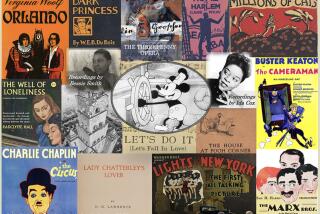The Cel: By and Large, Don’t Sell It Short
- Share via
“Animation art has shot up enormously in value--perhaps 30% a year--and certain items, particularly Disney cels, are appreciating even faster,” says art dealer Jerry Muller of Museum Graphics in Costa Mesa. “I’m tempted to say prices for cels have topped out--although every time I’ve said it, the market has made a fool out of me.”
The cels, drawing and preliminary sketches that studios once discarded, now sell at major art auction houses. Skyrocketing prices and the emergence of Hollywood figures like Steven Spielberg as collectors have made the artwork from animated films a desirable acquisition that straddles the line between fine art and collectibles.
The most desirable pieces in the current market are cels, sheets of clear acetate on which cartoon characters have been traced and painted. On June 8, Christie’s East--which used to include cels at the end of sales of American paintings “as a sort of joke”--will offer 226 lots of animation art, 90% of them cels. Estimated prices for cels with original backgrounds from Disney’s “Snow White and the Seven Dwarfs,” “Pinocchio” and “Bambi” range from $5,000 to $20,000.
Dealers and collectors anticipate an imminent rise in the prices of other forms of animation art--backgrounds, drawings, preliminary studies and sketches--which currently sell for a fraction of the cost of a cel. “Drawings will be the market of the future,” says Joshua Arfer, animation art specialist at Christie’s East. “They’re currently undervalued. You can still buy a great drawing for $300.”
Some collectors prefer drawings to cels because they represent the animators’ actual work, rather than a tracing. Stu Reisbord of the Cartoon Carnival Gallery in Wallingford, Pa., calls drawings “the heart, hand and soul of the films.” Preliminary studies are potentially the most valuable drawings; Disney hired noted artists and illustrators, including Kay Neilsen, Gustave Tenggren and Eyvind Earle, to do designs and inspirational work for his animated features. One of Earle’s backgrounds for “Sleeping Beauty” recently sold for $28,000.
“The fine-art world is just coming to realize the value of the original pencil concept sketches from animated films,” says Reisbord. “My feeling is that we’re just now seeing the very beginning of the market for both drawings and original painted backgrounds from animated films.”
Muller adds, “I’ve had people come up to me and say, ‘If I could afford to start collecting French Impressionist paintings, I would, but it’s too late to get into that ballgame. I can buy a piece of Disney concept art for $500, which I know is going to be worth a lot of money someday’--which I think is a correct assumption.”
Although no one social or economic group collects animation art, an increasing number of buyers are affluent young professionals. For baby-boomers, art from the classic Disney films has a sentimental significance that complements its investment value: “People buy what they grew up with,” says Muller, “and the kids who grew up watching ‘Sleeping Beauty’ and ‘Peter Pan’ are now making enough money to buy images from those films. And they’re paying top dollar for them.”
“Many big buyers collect this material not because they consider animation an art form but because the Disney films mean something to them,” Arfer says. “They can’t own Judy Garland in the ruby slippers, but they can have a real piece of a Disney film. A second group wants something to decorate their kid’s room--they just want something cute. The third group knows prices are rising and that some of the biggest names in Hollywood are serious collectors.”
“We’re getting new players in the field,” says Reisbord. “Many fine-art collectors are starting to see the value of this material and are realizing that it’s a bargain. They’re aware of what’s going on in art world, and they know what drawings by other artists are going for. A little sketch by Saul Steinberg may sell for $8,000 or $9,000, while you can get an original Disney rendering for a fraction of that.”
Ironically, the relatively inexpensive drawings may prove to be a more durable investment than the costly cels.
“The earliest cels I’ve seen are between 60 and 70 years old, and they invariably show some damage,” Arfer says. “Acetate is a non-porous surface--it was never meant to hold paint. Those older cels may last another 40 years. You can keep restoring them the way they’ve restored paintings for centuries, but that’s so expensive, it’s almost cheaper to buy new ones. I think most cels have a life expectancy of about 100 years, while a properly preserved drawing can last for centuries.”
More to Read
The biggest entertainment stories
Get our big stories about Hollywood, film, television, music, arts, culture and more right in your inbox as soon as they publish.
You may occasionally receive promotional content from the Los Angeles Times.










